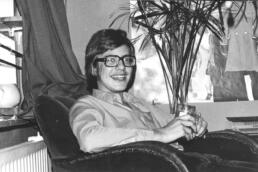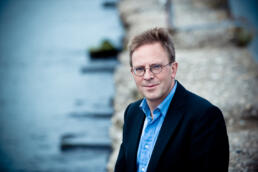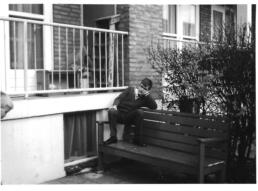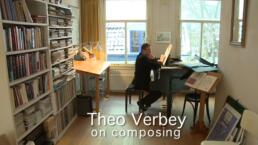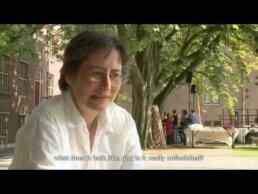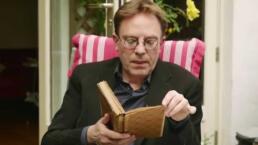Bio
Discovering the power of music
Theo Verbey was born in 1959 in Delft, the Netherlands. He discovered the power of music at the age of seven, as he played a simple recorder accompaniment during a school puppet show: “When I started to play during a ‘sad’ scene, my classmates’ jaws dropped. They stared at me, then at the puppet, then back at me. That was the moment I truly appreciated music’s ability to arouse emotion.” Theo began writing music soon after, taking music lessons at the Delft Music School and playing trumpet in Delft’s community orchestra. He also played the piano and wrote music for rock bands and cabaret groups.
Early recognition
Theo attended the Royal Conservatoire in The Hague, where he studied music theory from 1978 to 1984 and composition from 1982 to 1985 with Peter Schat and Jan van Vlijmen. While still a student, he received recognition for his orchestration of Alban Berg’s Piano Sonata op. 1. That work led to a lifelong passion for instrumentation, which he saw as a bridge to the past. Verbey’s work from the early eighties shows the influence of Pierre Boulez and Luciano Berio. He gradually developed his own style, however, integrating elements from American minimalism and basing his rhythmic and formal structures on mathematical principles.
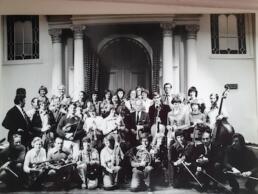
An internationally renowned Dutch composer
After completing his studies, Theo rapidly became one of the most-performed living Dutch composers, frequently turning for inspiration to history, current events, and literature. His work is often performed by Dutch and international orchestras and ensembles, and has been played at international festivals such as the Donaueschinger Musiktage (Germany), the Tanglewood New Music Festival (USA), the Holland Festival, the Huddersfield Contemporary Music Festival (UK) and the Venice Biennale (Italy).
The celebrated Concertgebouworkest commissioned Verbey to compose three pieces: Ariadne, Alliage, and LIED. He was composer-in-residence during the Brabants Orchestra’s sixtieth anniversary season in 2009-2010, for which he wrote Orchestral Variations. Theo Verbey collaborated across the spectrum, and his works also provided the basis for several successful ballets by Dutch choreographer Regina van Berkel. In 2010, Queen Beatrix chose Verbey’s completion of Stravinsky’s 1919 Les Noces for a national broadcast as part of that year’s annual Queens Day Concert.
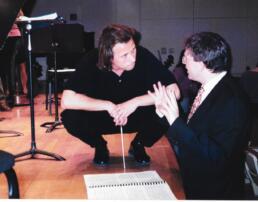
Support for young musicians
Theo Verbey was passionately committed to the education of young musicians. He began teaching at the Royal Conservatoire in The Hague when he was just 25, and joined the faculty of the Conservatorium van Amsterdam in 1995. A remarkable number of his former students have gone on to become leading composers and music-theoreticians in their own right. In 1992 and 1997, he was a member of the jury of the prestigious Queen Elisabeth International Composition Competition in Brussels.
In addition to the Berg Sonata, Verbey wrote sensitive and sympathetic orchestrations of works by Bach, Mussorgsky, Scriabin, Richard Strauss and others. As a teenager, Verbey once told a friend from his community orchestra that sometimes, when he couldn’t sleep, he would imagine arranging piano works by Shostakovich or Stravinsky for a huge orchestra, “sumptuous, with two contrabassoons.”
Theo Verbey’s completion of Stravinsky’s 1919 version of Les Noces features 16 vocalists and player piano, two cimbaloms, harmonium and percussion, and was subsequently performed during the Muziekfest Berlin. His close affinity with Alban Berg led him to arrange the three remaining movements of the Lyric Suite, so now the entire piece can be performed in the string orchestra version. Verbey also orchestrated three Mussorgsky song cycles: Sunless, The Nursery, and Songs and Dances of Death. He arranged Scriabin’s Preludes op. 33 for oboe, violin, viola and cello. His orchestration of Schubert’s Andante from the Piano Sonata in A has proved a popular favorite. We can now look forward to the world-premiere of his posthumously published instrumentation of Bach’s “Italian Concerto” BWV 971, and “Overture in the French Style” BWV 831.
Theo Verbey was captivated by mathematics and fractal theory—many of his pieces have a fractal structure, and the word Fractal appears in numerous titles. One Dutch obituary recounted, “As a child, Theo Verbey once put a math book on the piano and started playing. In retrospect, that scene has a symbolic value, because the correspondence between sound and numbers would continue to fascinate him.”
Theo Verbey was an avid reader and had an affinity with current events and the entire history of music, and that’s clearly recognizable in many of his works, such as:
- After the Great War, written to commemorate the end of WWI
- Traurig wie der Tod, for orchestra and chorus: Verbey’s “in memoriam” for those lost in the downing of flight MH17 above Ukraine
- Lumen ad Finem Cuniculi, written in tribute to the Dutch tradition of coal mining
Verbey also felt a strong affinity with literature. His final work, Ariadne, was inspired by Greek mythology. Other writers who sparked Verbey’s imagination include:
- Borges, in Verbey’s chamber music work, De Peryton
- Nabokov, whose book, Invitation to a Beheading, was at the heart of Verbey’s enigmatic and engaging work of the same name
- Lewis Carroll and his mythical creature Bandersnatch, which inspired Verbey to create an intriguing work for solo cello and player piano
A highly sought-after artist, Verbey’s works touch audiences well beyond the concert stage. His most recent collaboration was “Death in Venice,” a co-production with the Concertgebouworkest and Internationaal Theater Amsterdam, for which he made a version of two Strauss songs for counter-tenor and chamber orchestra. Verbey also collaborated with Klangforum Wien on their “Free Radicals” program, writing a score for Man Ray’s 1923 film, “Retour à la Raison.” Award-winning harpist Godelieve Schrama included a work by Verbey in her performance piece, “La harpe, c’est moi,” and Verbey also collaborated with Orkest Morgenstond to create an upbeat song for school children.
